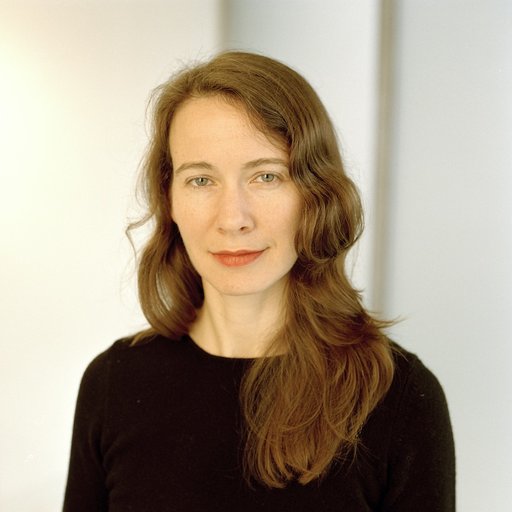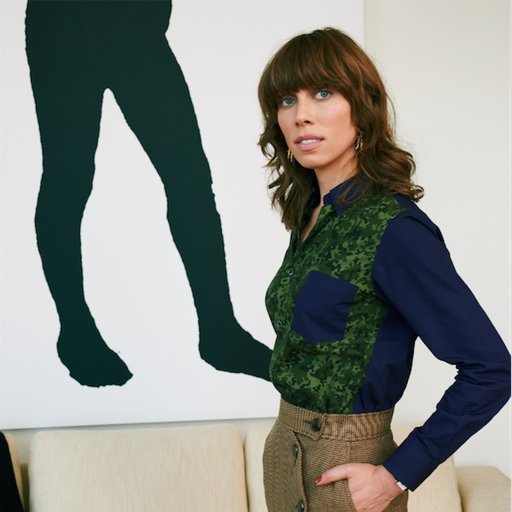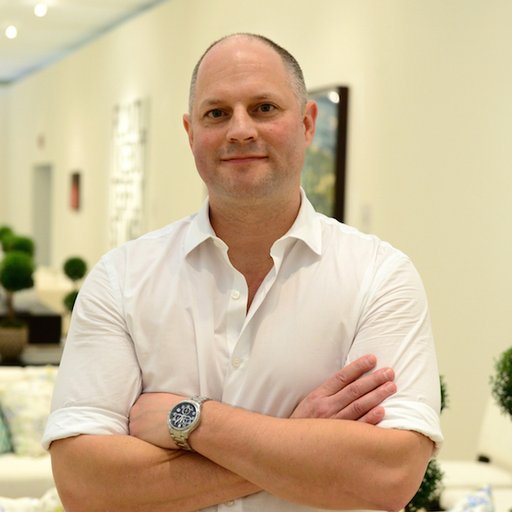When one thinks of the new generation of art dealers who have been transforming Los Angeles into a cynosure of the international contemporary art scene, David Kordansky stands out—and not just because of his height and Brillo-worthy hair that make him one of the easiest gallerists to spot at art fairs. From the moment he opened his first gallery in L.A.’s Chinatown in 2003, Kordansky has built a reputation as one of the sharper eyes in the business, making stars of young artists like Jonas Wood, Elad Lassry, and Thomas Houseago while at the same time investing the careers of under-appreciated veterans like Sam Gilliam and John Mason with renewed vigor and relevance. He also, it should be said, vibrates with a nearly religious devotion to the art itself, talking about its historicity and aesthetic achievement with anyone who steps within earshot.
Last year, Kordansky opened a new 12,000-square-foot space on South La Brea, designed by the sought-after Thai minimalist architect Kulapat Yantrasast. With a show of new work by the gallery’s newest recruit—the master ceramicist Betty Woodman—opening to coincide with this week’s L.A. art fairs, Artspace editor-in-chief Andrew M. Goldstein spoke to Kordansky about the origins of his gallery, the evolution of the city’s art scene, and his plans for the site.
When did it first dawn on you that art was something you wanted to devote your life and career to?
Well, I went to CalArts for graduate school, and prior to CalArts I studied at a very small art school in Hartford, Connecticut, called the Hartford Art School. Interestingly enough, it’s one of the first art schools in the entire country—it was originally located in the basement of the Wadsworth Atheneum which is, of course, our first public museum. RISD, Carnegie Melon, MICA, and all of these other schools based their programs on the foundation program at the Hartford Art School. But even before school, my mom loved art and would take me to museums, so art was sort of omnipresent growing up.
You started out as an artist, isn’t that right?
I always wanted to be an artist, and at CalArts I was making collaborative work with another fella named Jeff Kopp. We were doing quite a bit of performance as well as making these collaborative sculptures. We had actually grown up going to rival high schools and sort of knew each of each other through the local skate scene, and we were reintroduced when we both ended up going to Hartford Art School for undergrad. At that point he was two years ahead of me, and he ended up going to CalArts afterward, so that was kind of my impetus for applying to school there, so we could collaborate in grad school too. That’s really what brought me to Los Angeles.
What was the L.A. art scene like back then?
Oh my god! The L.A. art scene in the very early 2000s was completely, totally different than it is today. You had the sort of history of L.A. art between Mike Kelley, Paul McCarthy, Jim Shaw, and these other artists who put Los Angeles on the map. But what attracted me to L.A., in addition to working with Jeff, was that at the time there was a particular group of younger artists who were starting to get a kind of recognition in the city. You could almost call it a renaissance.
It began in the mid to late '90s, when there was a group of artists working at UCLA that included Evan Holloway, Jason Meadows, Liz Craft, Torbjörn Vejvi—a group of sculptors who were in an exhibition called “Mise en Scène” [2000], curated by Bruce Hainley at the Santa Monica Museum of Art. This exhibition in particular was a catalyst for my wanting to come to L.A., since here was a new kind of sculpture that really blew me away—it was very at-hand, utilizing temporal materials that were really different from what was being utilized in the New York art scene.
The New York art scene at the time, if you remember, was characterized by a lot of very large, very finished video installations. These artists who were working in L.A., on the other hand, had returned to object-making and a celebration of the idiosyncratic. They weren’t making “outsider art” because it was very aware of history, but they were not just speaking to the history of their professors like Paul McCarthy and Mike Kelley but also to the history of Los Angeles’s cultural production.
So, to use Evan as an example, he was a student of Charles Ray and Paul McCarthy, but he was also simultaneously looking at the new artists and some of the artists who were buried in the substrata of L.A.’s art history, like Wallace Berman and Bruce Conner. These young guys were spanning the spectrum of this history of art production in Los Angeles, and there really was a sense of a sort of renaissance, where not only were they receiving a great amount of attention but they were simultaneously paying a kind of a homage to a certain group of artists who had not received the international attention that they deserved.
How did UCLA become such an engine of this new art scene?
You know, in the '70s and '80s, everyone who was paying attention to art in L.A. was looking at CalArts, and most of the “professional” artists that came out of L.A. were CalArts grads. Then, in the mid to late '90s, you saw this shift that was partially due to an article that Dennis Cooper—who you have to remember was teaching at UCLA and Art Center—wrote for Spin magazine called “The Cool School,” which documented how the new eyes were moving away from CalArts to UCLA and Art Center.
So, mid to late 90’s, I applied to UCLA and didn’t get in, but I felt, “Well, I should still go out there,” because the work that was being made in L.A. excited me much more than what was going down in New York. The sensibility of the scene felt more punk, I suppose because there was less going on out here—there was more room to experiment, more room to let your life proceed by its own design, in a way.
How did you transition from wanting to be an artist to wanting to be on the other side of the equation, as a dealer?
Jeff and I started to get more interested in curating exhibitions together in alternative spaces and galleries. We were essentially putting our friends in these exhibitions, and I really loved the atmosphere. I loved the fact we had this opportunity. At that time we felt like the art world was disinterested in CalArts, but we decided we were going to take it on ourselves to try and get these guys some attention, so most of the artists in our shows were CalArts graduates.
So when you opened your first gallery in Chinatown in 2003, those were mainly CalArts grads?
Yeah, they were.
What was it like opening a gallery back then? Were there collectors who were interested in buying this kind of work?
There were definitely collectors in Los Angeles, though they were few and far between. It’s amazing to think about the amount of people who are participating now versus back then. I mean, back then certain collectors wouldn’t even cross the Highland [Avenue] line, meaning they wouldn’t even go downtown. Now there are all these galleries that are moving downtown, and there’s very much this amazing, vibrant, exciting scene going on with Laura Owens at 356 Mission and Night Gallery. But back in 2002 or 2003 certain collectors wouldn’t dare go downtown. That’s why I keep talking about a renaissance.
What was downtown like at the time?
It was just a ghost land. But what’s interesting is that Chinatown in the early 2000s also had China Art Objects, Daniel Hug Gallery, Peres Projects, Sister Gallery, Pruess Press, and Untitled, which is now Joel Mesler’s Untitled Gallery in New York. In terms of energy, it was the equivalent to what’s going on downtown now. The only reason we left Chinatown was because we needed more space, so we made the move to Culver City in 2008.
What were some of the most important early moments in the life of the gallery? What gave it its momentum?
There are many, but the one that stands out for me is the exhibition that we did with Aaron Curry in 2006 called “Bank Robber.” It was a momentous and historic moment for the gallery, and something that I remember vividly. I felt like it was the first exhibition that put us on the map, and it was the moment where we began to do outreach with an international collector base. Aaron’s show was groundbreaking in many ways for the gallery.
Was Aaron Curry one of your original CalArts guys?
No, interestingly enough. He was from Art Center, and he graduated with a group of artists that included Stephen Rhodes, Sterling Ruby, Nate Hylden, Heather Cook, and Kathryn Andrews. There was a great group of artists who came out of Art Center at that time, and those artists were all working with Mike Kelley and Richard Hawkins. That was an important moment for Art Center.
These artists are known for a kind of work that could even be termed pre-Post-Internet, mashing up styles from across eras to create novel sculptural groupings and installation that seemed incredibly fresh when it first appeared. Their style has really helped define the idiom of L.A. cool. What’s interesting is that you then matched up these artists with an older generation of artists, like the great American surealist John Wesley, the Washington Color School painter Sam Gilliam, the ceramicist John Mason, and Thomas Lawson, who was your dean at CalArts. What drew you to include them in your roster?
Well, take John Mason. The fascinating thing about John Mason is that if you look at the ceramic sculptures that were coming out of Los Angeles in the ’50s and ’60s, they were mainly tied to the Light and Space artists, which itself was another kind of minimalism. So, if you trace John Mason’s trajectory, he was making his brick sculptures 10 years prior to Sol LeWitt’s brick sculptures—he was engineering clay with a radical flair, and it preceded a lot of what Robert Morris and LeWitt were making in their work. But because the art world was so New York-centric, it was those artists who were centralized and favored over Mason’s more idiosyncratic kind of work, since clay was perceived as a more craft-oriented medium, even though Mason was thinking about it in a similar framework to the New York minimalists.
But, to more directly answer your question, you really want to create a healthy balance between young and old. You want there to be a cross-generational dialogue. You know, there’s so much mannerism within the art world today. It’s becoming harder and harder to differentiate one process-oriented, non-representational painter from the next. It’s a kind of posturing. Instead, I think that it’s valuable and it creates a kind of precedence for younger artists to exist in conversation with older, more seasoned veterans who have been through it all. I like the idea of thinking about Larry Johnson in relation to Elad Lassry, or John Mason in relation to Aaron Curry.
I want to show what I love whether the market approves of it or not. I’m going to show what I love, and it’s that simple, really. It’s not about being a contrarian—I’m just disenchanted with what’s going on out there, you know? What’s going on now is that you have the market dictating the decision-making for gallerists rather than the gallerists defining the marketplace. I’d rather go down in a blaze of glory then sell out, I suppose [laughs].
Now that you’ve moved beyond your original group of CalArts artists, how do you find new talent to bring into your gallery?
I’m always asked this question and I never really have an answer for it. I think art fairs are a great resource, but each artist has a different story around how we came to their work, and a lot of times we’re turned on to new artists’ work through our other artists. Kathryn Andrews might say, “Hey, check out this guy. I think he’s making really interesting stuff.” Often it’s our artists coming to us with particular ideas, particular names.
How did you come to work with Kathryn Andrews, for instance?
When I was in school, she was one of the first people I met in Los Angeles outside of CalArts, when she was at Art Center. We had known each other for a period of seven or eight years before ever starting to work together. But a number of the artists have also been introduced to me through my wife [the artist Mindy Shapero]. She’s been very much an advocate of so many artists that we’re now working with, like Ruby Neri and Mary Weatherford.
You spoke before about how collectors used to be leery of crossing Highland Avenue for new art. Now L.A. is filled with a new generation of collectors who seem intent on competing for the freshest works and who are willing to go anywhere and do anything to get them. Meanwhile, much has been made about the rise of the flipper-style collector, and the influx of celebrities into the art scene. How have you seen your collector base change over time?
Honestly, I don’t know if what we’re doing speaks to this new group of collectors. I think a lot of it is youth-based, youth-oriented—and L.A. has always been a city that’s been fascinated with youth culture. I don’t know if that’s our target audience, although we definitely work with individuals in the industry. In fact, there are incredible, incredible, incredible collectors who are coming out of the context of Hollywood. I would prefer not to name names but nonetheless I think this new group that you’re speaking of is actually quite different from some of these Hollywood individuals that I’m speaking of.
As for the Stefan Simchowitz crowd, Stefan is actually a very interesting, idiosyncratic guy. And he’s far from stupid, I want to make that clear. But I’m not sure that we’re catering to that audience. A lot of those guys are very interested in young art at a certain price point, as I understand it, and I think our artists may be past that.
Last year, you opened a spectacular new gallery space that affords you a cavernous new context for your artists. Now that you’ve settled in a bit, where do you feel the gallery is in its trajectory, and what new kinds of muscles are you able to flex in the larger space?
More than anything the new space allows us the opportunity to create these cross-generational dialogues and more idiosyncratic pairings of exhibitions, and, as in the case of Rashid Johnson and Jonas Wood, it allows us to produce monumental exhibitions that we would not have been able to do otherwise. There’s also a practicality to it as well. I mean, we were spending so much money on storage and rent—why not buy a space and build your ideal? One of my initial concepts was to get rid of the hierarchies between the project room and the gallery, to essentially create two spaces of identical size and proportion where there is no hierarchy, where you can have a young artist exhibiting in conversation with, say, a John Wesley. The art world suffers from amnesia—it has this very short-term memory and it’s moving at such a rapid pace. This allows us to slow time down a bit.
Speaking of time, the latest groundbreaking, hot artist that you’re working with is the legendary Betty Woodman, who you’re showing this weekend with an exhibition of new work. She’s in her mid-80s, but she’s making work that engages with the same kinds of spatial experimentation and fusions of painting and sculpture that your younger artists exhibit. How did she come to the gallery?
I’ve been a fan of Betty for years, ever since my best friend Stuart Krimko—who used to be one of the directors at the gallery—introduced me to her work probably 11 years ago. We’ve been in conversation with Betty for a good five years, discussing and planning this exhibition. It’s really extraordinary.
What’s in the show?
The exhibition is called “Illusion of Domesticity,” and it’s thematically based on domestic interiors and objects that collapse the distinctions between 2-D and 3-D space. There are incredible moments where you have these amazing square vessels become pictorial before your eyes, and then the canvas backdrops become sculptural. There’s an amazing shift between objects and space, with sections having an almost pop-up-book feel to them, with planar forms proposing three dimensionality, ceramic vessels posing as objects found within domestic interiors, and canvases themselves posing as rugs. It’s really, really gorgeous, and it’s super-contemporary.
Now L.A.’s Renaissance has become a fait accompli, with art fairs—like this week’s Art Los Angeles Contemporary and Paramount Ranch—tapping into the city’s cool factor and New York galleries, like Maccarone and Matthew Marks, streaming in to open new spaces in the city. Where exactly does L.A. stand today in its relationship with its arch-rival, New York?
L.A. will always be its own weird space. You have to remember that it’s a sprawling city—there’s no real center to it, and, because there’s no center, it allows for a multiplicity of voices. And there’s still space to be had out here. As long as there’s real estate left there will be room for new positions and new voices.
























